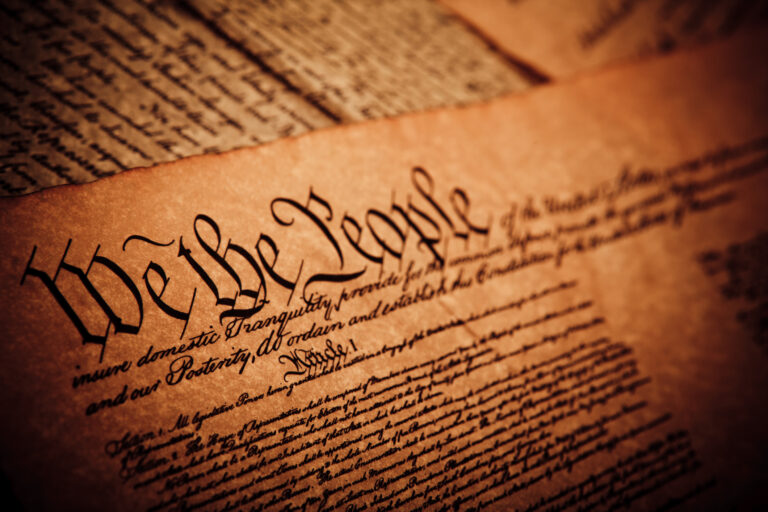The Commerce Clause made easy

The federal government asserts most of its modern regulatory power over the individual ostensibly under the Commerce Clause, and therefore, it’s important for anyone who loves liberty to understand its true scope.
This article looks at the clause’s background and then the two main powers that it gives the federal government.
Background of the Commerce Clause
The federal government has only the limited powers that the U.S. Constitution specifically grants it. Conversely, the states retained the general power that individuals delegate to civil governments for promoting public safety, health, and welfare (also known as the “police power”). The Tenth Amendment confirms this structure by reserving to the states or to the people “[t]he powers not delegated to the United States by the Constitution.”
One of the limited powers that the Constitution delegates to the federal government is regulating “commerce . . . among the several States.” This departed from the Constitution’s predecessor, the Articles of Confederation, which did not give the federal government the power to regulate interstate commerce. In the opinion for Tennessee Wine and Spirits Retails Association v. Thomas, the Supreme Court wrote, “Under the Articles of Confederation, States notoriously obstructed the interstate shipment of goods.” Thus, “removing state trade barriers was a principal reason for the adoption of the Constitution.”
The convention that drafted the Constitution was called for the express purpose of addressing interstate commerce. In The Federalist Papers numbers 7, 11, and 42, authors Alexander Hamilton and James Madison urged Americans to ratify the Constitution to foster “free trade among the States” and thereby reduce the chances of trade wars (and kinetic wars) between the states. This argument persuaded Americans and they ratified the Constitution, including its Commerce Clause.
The regulatory powers of Congress
As currently interpreted, the federal government’s legislative power can be divided into three categories. First, in the case Perez v. United States, it was decided that Congress can regulate the channels of interstate commerce, such as prohibiting individuals from misusing those channels to transport stolen goods or kidnapped persons across state lines.
Second, it can regulate the means of interstate commerce, such as ships, railroads, and airplanes, as was affirmed in United States v. Patton. Thus, Congress may prohibit activities like destroying an aircraft or stealing goods from an interstate shipment.
Third, it can regulate intrastate activities if they substantially affect interstate commerce. The substantial affects test gives the modern federal government much of its current regulatory powers. It’s also the most controversial. This is because “[u]nder the first two categories Congress may regulate or protect actual interstate commerce, [but] the third allows Congress to regulate intrastate noncommercial activity, based on its effects.” Not only that, this test allows Congress to regulate intrastate activities that have only a “trivial” effect on interstate commerce, if there is a “rational basis” for concluding that those activities “taken in the aggregate, would substantially affect interstate commerce.”
The Supreme Court has upheld a federal regulation limiting the amount of wheat that a small farm could grow because it enabled Congress to set the national price for wheat. Likewise, the Court upheld the federal ban on growing marijuana even as applied to growing it at home for one’s personal medicinal use in Gonzales v. Raich. Thus, as Justice Thomas has criticized, “[t]he aggregation principle is clever, but has no stopping point.” As he concludes, the substantial affects test perverts the Commerce Clause into a national police power allowing the federal government to do whatever it wants.
Indeed, the substantial affects test starkly departs from the original public meaning of the Commerce Clause. Under that original meaning, Congress may regulate only the “selling, buying, and bartering” of goods and services that cross states lines. Accordingly, in 1895, the Supreme Court held that the power to regulate interstate commerce does not include the power to regulate manufacturing, even if there’s an “indirect relationship” between the two (i.e., even if manufacturing affects interstate commerce).
And as late as 1936, the Court held that the power to regulate interstate commerce did not include the power to regulate working conditions in mines, even if they “greatly affected” interstate commerce. In that case, the Court even cautioned that the convention that drafted the Constitution considered granting the federal government a power to legislate where the “separate States are incompetent” but rejected granting Congress authority “to legislate substantively for the general welfare.” It warned that “[e]very journey to a forbidden end begins with the first step.” It concluded that allowing the federal government to regulate miners’ employment would be a first step toward the Commerce Clause eviscerating the states’ power over local affairs. .
But the following year, the Court took not just a step but a leap toward expanding the federal government’s powers when it adopted the substantial affects test and allowed federal regulation of employees’ working conditions. The Court’s sudden about-face (and faceplant) was a response to President Franklin Roosevelt’s “court-packing” plan to expand the numbers of Justices on the Court. Since then, the Court has allowed the federal government to rapidly expand its control over the economy and ultimately over individuals under the guise of regulating interstate commerce.
But thankfully, the modern Supreme Court has started to limit the substantial affects test. In two cases, Lopez and United States v. Morrison, the Court held that the Commerce Clause did not extend to certain noneconomic activities (carrying a gun in a school zone in one case and committing violence based on gender in the other) that were unrelated to a more comprehensive scheme of regulating interstate economic activities. In a third case, Gonzales v. Raich, one Justice noted that the “substantial affects” test comes not from the Commerce Clause but from the Necessary and Proper Clause. This at least suggests that certain exercises of federal power under the substantial affects test are not “proper” (a step in the right direction).
Pacific Legal Foundation actively sues the federal government to limit the reach of its Commerce Clause powers over the individual. In a recent Supreme Court victory, PLF won a case where the Court interpreted the Clean Water Act as not applying to bodies of water that were not physically adjacent to a traditional waterway, such as a river. Two Justices in that case wrote a concurring opinion arguing that the Court’s invention of the substantial affects test was partly to blame for the EPA’s aggressive interpretation of its statutory authority. They also reiterated that the original meaning of the Commerce Clause did not include the power to regulate agriculture or manufacturing.
While the Supreme Court’s current interpretation of the Commerce Clause often allows the federal government to engage in regulatory overreach, recent cases offer hopeful signs that this can change. PLF will continue to file lawsuits that protect individuals from the current misinterpretation of the Commerce Clause (specifically the substantial affects test).
The dormant Commerce Clause
Under current interpretation, the Commerce Clause also has a “dormant” or “negative” aspect that allows courts to strike down state laws that discriminate against out-of-state economic interests.
While Congress has used the Commerce Clause to expand the federal government’s power to the detriment of individual liberty, courts have used the “dormant” side of the Commerce Clause to protect individuals from protectionist state laws. For example, the Court recently struck down Tennessee’s two-year residency requirement for applying for a retail license to sell alcohol.
Pacific Legal Foundation uses the “dormant” side of the Commerce Clause to fight state laws that protect or favor in-state businesses that give them a competitive advantage over out-of-state businesses. Just last year, PLF won a case, Truesdell v. Friedlander, where the court ruled that Kentucky violated the dormant Commerce Clause when it denied a business permit to an out-of-state business on the grounds that it did not want additional interstate competition. In MacDonald v. Sabando, PLF brought a dormant Commerce Clause challenge to New Jersey’s prohibition on out-of-state doctors providing follow-up treatment over video chat even if the patient had received prior in-person treatment in the state where the doctor physically practices.
Whether it’s fighting federal government overreach that arises from a wrong understanding of the powers of Congress under the Commerce Clause, or fighting protectionist state laws under the dormant Commerce Clause, PLF is committed to leading the way in the fight for individual liberty.





